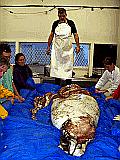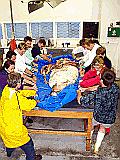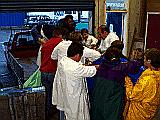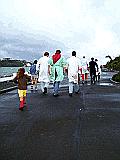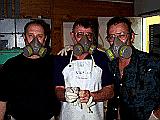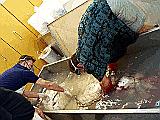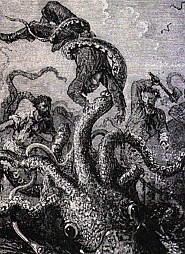 Most of everything we know about the giant squid (Architeuthis sp.) has
come from the examination of animals that have either been washed up on
beaches, spit up by sperm whales or caught accidentally in large fishing
trawls. Because of the relative rarity of well preserved specimens,
whenever one is
found,
there is an opportunity
to learn something new about this elusive creature.
Most of everything we know about the giant squid (Architeuthis sp.) has
come from the examination of animals that have either been washed up on
beaches, spit up by sperm whales or caught accidentally in large fishing
trawls. Because of the relative rarity of well preserved specimens,
whenever one is
found,
there is an opportunity
to learn something new about this elusive creature.
Recently, a number of giant squid have been caught in the large,
deep-water fishing trawls in the waters around New Zealand and
Australia. One in particular, caught just a few weeks ago in the
waters just south of Kaikoura Canyon, was recovered in excellent
condition and was awaiting Clyde's arrival, safely stored in a large,
walk-in freezer here at the NIWA lab.
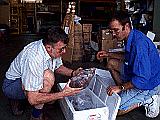 Every so often, a large refrigerated truck pulls up to Steve O'Shea's
back door and deposits a large bag or box containing the frozen remains
of some sea creature that has been found. In addition to his job as
curator of the collection of marine organisms, Steve is also the guy
that most fisherman know is the person who wants any giant squid that
may accidentally get caught in one of their trawl nets. Some fishing
boats have observers on deck who quickly bag and freeze any squid that
may come on board - not an easy task when you are faced with a 200
kilogram or more mass of very unresponsive squid on the heaving deck of
a working fishing boat.
Every so often, a large refrigerated truck pulls up to Steve O'Shea's
back door and deposits a large bag or box containing the frozen remains
of some sea creature that has been found. In addition to his job as
curator of the collection of marine organisms, Steve is also the guy
that most fisherman know is the person who wants any giant squid that
may accidentally get caught in one of their trawl nets. Some fishing
boats have observers on deck who quickly bag and freeze any squid that
may come on board - not an easy task when you are faced with a 200
kilogram or more mass of very unresponsive squid on the heaving deck of
a working fishing boat.
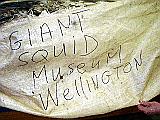 The markings on the outside of the bags are often a wonder of
understatement. This particular specimen came wrapped in a very large
brown sack with the words "Giant Squid, Museum Wellington" scrawled
across the outside. For the past few days, this bag has been sitting
on one of the large dissection tables at the NIWA lab, thawing
gradually, awaiting today's activities.
The markings on the outside of the bags are often a wonder of
understatement. This particular specimen came wrapped in a very large
brown sack with the words "Giant Squid, Museum Wellington" scrawled
across the outside. For the past few days, this bag has been sitting
on one of the large dissection tables at the NIWA lab, thawing
gradually, awaiting today's activities.
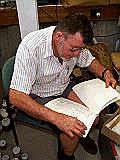 Last night, Clyde and Steve
went through many of the published reports of giant squid observations
in an effort to come up with a list of all the key measurements that
Clyde and Mike would be making the next day.
This list filled several pages of Clyde's bright red notebook. Some of the
measurements
like Mantle Length, Mantle Width, and Arm Length are
fairly obvious. Ones like the thickness of the mantle, or the
circumference of each arm at the base were a little less obvious (to me
at least) and a little more difficult to actually make as you shall
see.
Last night, Clyde and Steve
went through many of the published reports of giant squid observations
in an effort to come up with a list of all the key measurements that
Clyde and Mike would be making the next day.
This list filled several pages of Clyde's bright red notebook. Some of the
measurements
like Mantle Length, Mantle Width, and Arm Length are
fairly obvious. Ones like the thickness of the mantle, or the
circumference of each arm at the base were a little less obvious (to me
at least) and a little more difficult to actually make as you shall
see.
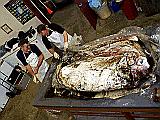
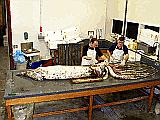 Making sure that they had everything, Mike and Clyde
wheeled the cart
containing all the cameras, dissecting tools and waterproof clothing
(boots, gloves and aprons) along the path by Evans Bay to the lab where
the squid was thawing. The first thing that they needed to do after
making sure that the squid was defrosted enough to easily reposition
without doing any damage to it, was to gently
unfold the squid and
begin to arrange it
in a more "natural"
position. In order to fit into
the ship's freezer, the squid's arms had been folded back along the
mantle, bending the head in the process. With great care, they were
able to extend the arms until the squid very nearly filled the entire
length of the dissection table.
Making sure that they had everything, Mike and Clyde
wheeled the cart
containing all the cameras, dissecting tools and waterproof clothing
(boots, gloves and aprons) along the path by Evans Bay to the lab where
the squid was thawing. The first thing that they needed to do after
making sure that the squid was defrosted enough to easily reposition
without doing any damage to it, was to gently
unfold the squid and
begin to arrange it
in a more "natural"
position. In order to fit into
the ship's freezer, the squid's arms had been folded back along the
mantle, bending the head in the process. With great care, they were
able to extend the arms until the squid very nearly filled the entire
length of the dissection table.
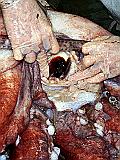 Based on this specimen, there is no doubt that giant squid contain the
dark, sepia-colored ink that we associate with the smaller, more
familiar squid. The entire squid, and very soon all of us were covered
with it. Clyde took a hose and very carefully
washed the entire squid
from head to toe (oops, I meant arms to tail). In the process, Clyde
gave me a quick lesson in giant squid anatomy pointing out such
features at the large, parrot-like
beak at the
base of the 8 arms, and the two, very large
gills
resting inside the mantle cavity.
Based on this specimen, there is no doubt that giant squid contain the
dark, sepia-colored ink that we associate with the smaller, more
familiar squid. The entire squid, and very soon all of us were covered
with it. Clyde took a hose and very carefully
washed the entire squid
from head to toe (oops, I meant arms to tail). In the process, Clyde
gave me a quick lesson in giant squid anatomy pointing out such
features at the large, parrot-like
beak at the
base of the 8 arms, and the two, very large
gills
resting inside the mantle cavity.
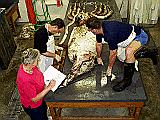 Once the squid had been thoroughly cleaned and arranged, the work of
making the
measurements began.
Using a long piece of string and a
measuring board, Mike and Clyde measured widths, lengths, diameters,
circumferences and thicknesses of many things that I had never heard of
in my life. Thankfully, Ingrid understood and stood by with the red notebook,
calling out the next measurement that needed to be made and then
carefully recording the number that was given to her, and repeating it
for confirmation.
Once the squid had been thoroughly cleaned and arranged, the work of
making the
measurements began.
Using a long piece of string and a
measuring board, Mike and Clyde measured widths, lengths, diameters,
circumferences and thicknesses of many things that I had never heard of
in my life. Thankfully, Ingrid understood and stood by with the red notebook,
calling out the next measurement that needed to be made and then
carefully recording the number that was given to her, and repeating it
for confirmation.
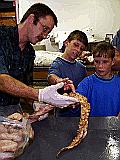 I guess the word had gotten out about the giant squid that was being
examined today, because all during the day, large numbers of
curious visitors,
many of them affiliated with NIWA in one way or another,
cautiously stepped into the lab and asked if they could have a look at
this creature whom most had only ever read about, but never seen. It
was a rather surreal scene watching Mike and Clyde going about their
often grisly work while people posed for pictures in the background.
At one point,
Steve's wife and parents
came in to visit both with Steve AND the
squid.
I guess the word had gotten out about the giant squid that was being
examined today, because all during the day, large numbers of
curious visitors,
many of them affiliated with NIWA in one way or another,
cautiously stepped into the lab and asked if they could have a look at
this creature whom most had only ever read about, but never seen. It
was a rather surreal scene watching Mike and Clyde going about their
often grisly work while people posed for pictures in the background.
At one point,
Steve's wife and parents
came in to visit both with Steve AND the
squid.
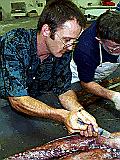 Through the morning and into the late afternoon the
measuring,
counting
and sampling continued until finally, everything that needed to be
measured, counted or sampled, had been. Because this particular
specimen, which according to Clyde was the most perfectly intact one
that he had ever worked on with only the two long feeding tentacles
missing, was destined for display in a museum, it needed to be
preserved until it could be put on display. Since there are not too many
little glass jars
that could contain something this big, Steve
spent about an hour injecting over 5 liters of formalin into it with a
large syringe before moving it later in the evening into a large,
coffin-like metal box filled with the preservative.
Through the morning and into the late afternoon the
measuring,
counting
and sampling continued until finally, everything that needed to be
measured, counted or sampled, had been. Because this particular
specimen, which according to Clyde was the most perfectly intact one
that he had ever worked on with only the two long feeding tentacles
missing, was destined for display in a museum, it needed to be
preserved until it could be put on display. Since there are not too many
little glass jars
that could contain something this big, Steve
spent about an hour injecting over 5 liters of formalin into it with a
large syringe before moving it later in the evening into a large,
coffin-like metal box filled with the preservative.
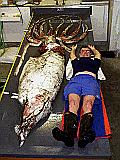 However, one of
the things that most of us commented on during the day was how
relatively clean and fresh the squid actually smelled. Half expecting
to be overwhelmed by the smell of either rotting flesh or of ammonia as
was described in some of the giant squid literature, it was almost like
being in a well maintained fish market.
However, one of
the things that most of us commented on during the day was how
relatively clean and fresh the squid actually smelled. Half expecting
to be overwhelmed by the smell of either rotting flesh or of ammonia as
was described in some of the giant squid literature, it was almost like
being in a well maintained fish market.
Clyde, never being one to miss an opportunity to make a point in the
most dramatic way possible, quite visibly
demonstrated how pleasant
smelling the squid actually was. Although he vowed that he would
regret it later, I was able to convince Clyde to provide a
representative sense of scale for the giant squid by climbing up on the
table and letting me take a picture of man and beast. However, the
only way that I was able to do that was by climbing up there and doing it
first.
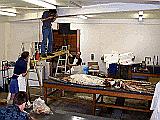 Since most squids are rarely in this incredibly good condition,
everyone thought that it should really be photographed before going
into the bath of formalin. Looking around the lab to see what we had
to work with, I found two ladders and a couple of boards. Building a
makeshift scaffold that straddled the dissecting table, I climbed up
the ladder, walked out onto the boards (while Clyde and Mike both held
onto the base of the ladders and looked on in slight disbelief) and
with my head braced against the ceiling, took a picture as close to
vertical that I could. We then moved the ladder a few feet further
down the table and the process was repeated. The picture below is one
of the first, full color composites of a giant squid taken from
straight above rather than at the rather low oblique angle that often
appears in the literature.
Since most squids are rarely in this incredibly good condition,
everyone thought that it should really be photographed before going
into the bath of formalin. Looking around the lab to see what we had
to work with, I found two ladders and a couple of boards. Building a
makeshift scaffold that straddled the dissecting table, I climbed up
the ladder, walked out onto the boards (while Clyde and Mike both held
onto the base of the ladders and looked on in slight disbelief) and
with my head braced against the ceiling, took a picture as close to
vertical that I could. We then moved the ladder a few feet further
down the table and the process was repeated. The picture below is one
of the first, full color composites of a giant squid taken from
straight above rather than at the rather low oblique angle that often
appears in the literature.
Regardless, with good humor, great strength and incredible care, the
squid was
gently lifted
off the dissecting table so that a large blue
plastic tarp could be placed beneath it. Like two anxious parents,
both Clyde and Steve were
on the table
with the squid, orchestrating
each maneuver so as not to damage any of the squid's rather delicate
parts. With great coordination, the squid was finally
lifted off the table with a collective grunt
from all participants. It was my good
fortune to have the job of photographer so I got to stand off in the
distance rather than risk embarrassing myself and demonstrate my lack of
strength.
Formalin is a very nasty chemical and not one to be treated lightly.
Careful to minimize anybody's exposure to the fumes (the
children were not allowed anywhere near the room in which it was kept)
Steve and Clyde gave all the folks very careful instructions as to what
to do, what not to touch and made sure that things went as smoothly and
as QUICKLY as possible.
 Every so often, a large refrigerated truck pulls up to Steve O'Shea's
back door and deposits a large bag or box containing the frozen remains
of some sea creature that has been found. In addition to his job as
curator of the collection of marine organisms, Steve is also the guy
that most fisherman know is the person who wants any giant squid that
may accidentally get caught in one of their trawl nets. Some fishing
boats have observers on deck who quickly bag and freeze any squid that
may come on board - not an easy task when you are faced with a 200
kilogram or more mass of very unresponsive squid on the heaving deck of
a working fishing boat.
Every so often, a large refrigerated truck pulls up to Steve O'Shea's
back door and deposits a large bag or box containing the frozen remains
of some sea creature that has been found. In addition to his job as
curator of the collection of marine organisms, Steve is also the guy
that most fisherman know is the person who wants any giant squid that
may accidentally get caught in one of their trawl nets. Some fishing
boats have observers on deck who quickly bag and freeze any squid that
may come on board - not an easy task when you are faced with a 200
kilogram or more mass of very unresponsive squid on the heaving deck of
a working fishing boat.
 Most of everything we know about the giant squid (Architeuthis sp.) has
come from the examination of animals that have either been washed up on
beaches, spit up by sperm whales or caught accidentally in large fishing
trawls. Because of the relative rarity of well preserved specimens,
whenever one is
found,
there is an opportunity
to learn something new about this elusive creature.
Most of everything we know about the giant squid (Architeuthis sp.) has
come from the examination of animals that have either been washed up on
beaches, spit up by sperm whales or caught accidentally in large fishing
trawls. Because of the relative rarity of well preserved specimens,
whenever one is
found,
there is an opportunity
to learn something new about this elusive creature.











